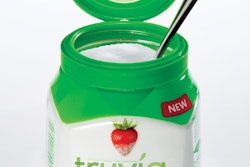Picking up on last month’s Q&A with James Tupper of IGD, we engage IGD again and look this month at research and commentary on Retail-Ready Packaging (RRP) from IGD’s Stewart Samuel. A senior business analyst with IGD who is based in Vancouver, BC, Canada, Samuel conducted an exclusive RRP survey in the second quarter of this year that consisted of two parts. Part One was an online poll of major retailers (30 respondents) and their suppliers (144 respondents). Part Two consisted of interviews with senior global sales and supply chain execs. Here’s our Q&A with Samuel.
Packaging World: Can RRP be viewed as a single solution?
Stewart Samuel
We view it as consisting of essentially four solutions. Shelf-Ready refers to a corrugated tray full of primary packages. Display-Ready is a self-standing pallet, typically but not always at the aisle end, containing primary packages.
Replenishment-ready is, for example, a band around six bags of lettuce or salty snacks that unitizes the six packs into one unit until the store staff removes it; it’s invisible to the shopper, but it greatly enhances a store worker’s ability to re-stock quickly. Finally, there’s Infrastructure-Ready, and the primary example of that would be rolling pallets stretchwrapped throughout distribution and then rolled into position in the store once the stretch wrap is removed.
One interesting discovery to come out of the survey was that suppliers are looking to multipurpose their packaging so that it can function as either a Shelf-Ready or a Display-Ready solution. They’re looking for efficiencies. Ideally they want one common solution, or at least not a proliferation of solutions for different retailers. They see it as a way of keeping complexity out of their supply chain.
Another key point that comes through in our research is that even in one category you can use a mix of these solutions. Really high-volume lines may be suitable for the rolling pallets. Next to it may be slower moving lines in Shelf-Ready format. Suppliers should think about the broad range of solution types and maybe use more than one in a category.
Has RRP spread uniformly across the global marketplace?
The UK seems to have caught on to this earliest and remains the most advanced. Also right there with the UK is Germany, where two large chains, Aldi and Lidl, command a sizeable portion of the market. To trade with them you almost have to be in RRP, and it’s been that way for 20 years. Spain and France are second and Australia has a big push on as Coles and Woolworths have about 60 percent of the market. North America is still behind if you compare it to other parts of the world, but Walmart has some initiatives with their supplier base in Canada, and that may be a sort of test bed for further development in the rest of North America. Figure 1 provides a nice snapshot of what retailers across the world are saying about the status of RRP in their organizations. As you can see, only 4% said they had no plans at all for RRP.
Is RRP a replacement for Every Day Low Pricing?
The EDLP model is what we refer to as “the virtuous circle.” On paper, it works like this: Lower in-store pricing drives more traffic in the stores so retailers can sell more volume which will drive operating/scale/distribution efficiencies which lets retailers gain some buying efficiencies which lets them further reduce their in-store prices. But a number of factors are currently challenging the retailers’ EDLP operating model. Consumers are under pressure, unemployment is high, governments across the world are cutting back on public spending, and confidence in the recovery is low. At the same time, higher commodity prices are hampering retailers’ ability to keep costs low, which in turn restricts retailers’ ability to reduce prices in some categories. Additionally, retailers are facing longer-term cost increases in some areas like fuel prices. It’s a combination of factors that means retailers can’t rely on EDLP alone.
What are retailers and suppliers saying about benefits that have been achieved through RRP initiatives?
Figure 2 gives us some idea. When you lump together all suppliers, 50% would say no benefits have been achieved to date. But when you segregate out just the UK suppliers, only 39 percent of suppliers say no benefits. So in the region where RRP is most advanced, 61% of the suppliers are recognizing benefits in RRP. As for retailers, only 29% say they have seen no benefits, which means, of course, that 71% of retailers are seeing benefits.
How does RRP fit into the whole sustainable packaging scene?
Some RRP solutions significantly reduce the amount of packaging materials used. The rolling pallet is a good example. Other RRP solutions may add to the amount of secondary packaging but reduce the amount of primary packaging. From a sustainable packaging standpoint this is seen as beneficial because retailers have proven they are pretty good at recycling whatever secondary packaging materials come into their stores. The same cannot be said where individual households and primary packaging are concerned, so if you reduce the amount of packaging that goes into the households, it’s a step in the right direction.
How would you describe the way in which suppliers are responding to this issue? Supplier engagement falls into six camps, which you see in Figure 3. At one end are resistors and at the other end are anticipators. Predictably enough, the bulk of the suppliers, 60%, are what we call followers. One thing the followers won’t have to worry about is encountering some of the pitfalls encountered by the anticipators. But it’s also true that the followers will never come up with solutions characterized by the highest levels of innovation. It’s the anticipators who specialize in innovation. What are the implications of Figure 4?
While 74% of suppliers and 57% of retailers have measured RRP’s impact on cost, few have measured the impact of RRP on sales, availability, or the shopper’s experience. This is a problem, because if you are fixated too much on cost you may not explore the range of options available or maximize the potential benefits of RRP. What we sometimes see happening is that the analysis of cost, which always comes early on, reveals that there has not been a cost savings or that cost has actually gone up. Then when it comes to what might be called the second wave of investment in RRP, it becomes more difficult to get the sign off required or to even drive internal engagement on RRP. We feel it’s important to analyze those other three areas aside from cost, particularly the impact on the shopper.
How important is retailer/supplier collaboration?
Clearly, greater collaboration is needed. If you look at Figure 5, only 15% of suppliers (6% + 9%) believe there is a collaborative approach in place; 70% of retailers (48% + 22%) believe they’re working in a collaborative manner. There’s a mismatch in the views of the two camps. We see it again when the two camps were asked if retailers are pushing ahead with RRP despite acknowledging supplier challenges. A total of 88% (62% + 24%) of suppliers agree while only 31% of retailers (22% + 9%) agree.
Suppliers want more communication and collaboration from retailers. They’d like retailers to more fully appreciate the total Supply Chain impact of RRP implementation. More sharing of data they’d like, too, and improved execution of RRP at the store level. Meanwhile, a key desire on the part of the retailers is that more suppliers view RRP as a sales growth opportunity. They’d like more suppliers to take a shopper-centric approach, to view it from the shelf backwards. Start with the shopper’s experience at the shelf and develop solutions backwards from there. There’s a huge branding and marketing opportunity for suppliers if they properly utilize the lip of that corrugated tray that so often is the merchandising unit deployed in RRP. It’s a chance to have your brand stand out in the category or communicate some sort of unique attributes of your product that would otherwise require a large marketing budget to achieve.
The Grocery Manufacturers Association has formed a subcommittee on RRP. Are other organizations mobilizing in similar ways?
The Canadian Council of Grocery Distributors and the Food and Consumer Products of Canada organization have formed an industry RRP committee and have come to an agreement on a shelf depth of 22 inches, something we have not seen anywhere else in the world. That’s fantastic news for suppliers because it’s easier to develop one solution that works across all retailers if you know the shelf depth is always consistent. Other countries have also formed industry workgroups such as ECR Australasia’s Retail Ready Packaging Workgroup.
Any final thoughts on RRP?
Suppliers will likely be more successful in their response to the RRP challenge if they view it as an opportunity to drive shopper engagement and volume growth rather than viewing it as an added business cost. It’s also important that suppliers look beyond their own categories for inspiration, innovation, and best-practice examples. And they’ll have to keep an eye on retailer sustainable packaging agendas, too.
Finally, more collaboration between retailers and suppliers could go a long way. It’s important that both camps stay focused on the last 50 yards. Suppliers and retailers have worked smartly over the past five years optimizing supply chain behavior, driving efficiencies, and investing in new and better methods from the supplier DC right through to the retailer DC right to the back of the store. But there can still be a disconnect between what’s in the back of the store and what’s actually out there on the floor for the consumer to buy. That last 50 yards should always be a key focus for retailers and suppliers alike.

























